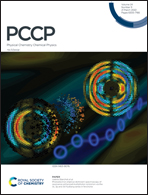Exploring the trimerization process of a transmembrane helix with an ionizable residue by molecular dynamics simulations: a case study of transmembrane domain 5 of LMP-1†
Abstract
The oligomerization of membrane proteins is an important biological process that plays a critical role in the initialization of membrane protein receptor signaling. Unveiling how transmembrane segments oligomerize is critical for understanding the mechanism of membrane receptor signaling activation. Owing to the complicated membrane environment and the extraordinary dynamic properties of the ionizable residues in the transmembrane segment, it is extremely challenging to thoroughly understand the oligomerization process of the transmembrane domain. In this study, transmembrane domain 5 (TMD5) of latent membrane protein-1 from Epstein–Barr virus was used as a prototype model to investigate the trimerization process of the transmembrane segment with ionizable residues. The trimerization process of TMD5 was rebuilt and investigated via conventional molecular dynamics simulations and constant-pH molecular dynamics simulations. When TMD5s approached each other, the tilting angles of the TMD5 monomer decreased. TMD5s formed stable trimers until two interacting sites (D150s and Q139s) along each transmembrane helix were created to lock the TMD5s. The pKa values of D150 shifted toward neutral states in the membrane environment. When TMD5s were monomers, the pKa shift of D150 was mainly influenced by its microenvironment in the lipid bilayer. When TMD5s were moving close to each other, protein–protein interactions became the main contributing factor for the pKa shift of D150s. Overall, this work elucidates the behavior of the TMD5 helix and the pKa shift of ionizable residue D150 in the process of TMD5 oligomerization. This study may provide insight into the development of agents for targeting the oligomerization of membrane proteins.



 Please wait while we load your content...
Please wait while we load your content...